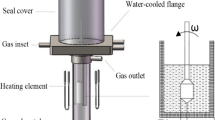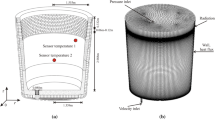This article is concerned with one of the most important directions in energy and resource conservation in metallurgy—recycling of converter slag and the resulting enhancement of the refractory lining stability. Investigations using the Ribould and Urbain models where the dynamic viscosity of slag at temperatures from 1500 to 1650°C was determined on the basis of the chemical composition of slag from a Polish metallurgical combine are presented together with a comparative analysis with the results of the Fact Sage program. Computational results where the effect of FeO on slag viscosity for FeO content in the slag ranging from 5 to 30% are presented.






Similar content being viewed by others
Notes
Here and below the weight content, %.
References
K. Ughadpada, S. Briglio, and G. Mohammed, “Production improvement of No. 2 BOSP at ESA,” Iron Steel Technol., No. 11, 59 – 64 (2010).
R. P. Stone, D. Neith, and S. Koester, “Further process improvements at Severstal Sparrows Point via new technology implementation,” AISTech Proc., No. 1, 737 – 747 (2009).
M. Ciechanowska and J. Pieprzyca, “Model research of the maintenance of the refractory lining of the BOF with “slag splashing” method,” Hutnik Wiadomooeci Hutnicze, No. 81, 136 – 141 (2014).
E. V. Protopopov, A. G. Chernyatevich, S. V. Feiler, and E. N. Sigarev, “New technologies for depositing slag skull on converter linings,” Izv. Vyssh. Uchebn. Zaved., Chern. Metall., No. 6, 7 – 11 (2014).
A. S. Nikiforov, E. V. Prikhod’ko, A. K. Kinzhibekova, and A. E. Karmanov, “Investigation of the ultimate strength of periclase-carbon refractory materials and analysis of their high temperature strength,” Steklo Keram., No. 4, 32 – 35 (2014); A. S. Nikiforov, E. V. Prikhod’ko, A. K. Kinzhibekova, and A. E. Karmanov, “Investigation of the ultimate strength of periclase-carbon refractory materials and analysis of their high temperature strength,” Glass Ceram., 71(3 – 4), 137 – 139 (2014).
D. Kalisz, “Viscosity calculation of mold slag in continuous casting,” Arch. Mater. Sci. Eng., No. 58(2), 164 – 170 (2012).
D. Kalisz, “Influence of casting mold slag on the progress of casting process,” Arch. Metall. Mater., No. 58(1), 35 – 41 (2013).
D. Kalisz, “Modeling physicochemical properties of mold slag,” Arch. Metall. Mater., No. 59 (1), 149 – 155 (2014).
K. C. Mills, “Estimating the physical properties of slags,” J. South. African Inst. Mining Metall., No. 111, 649 – 658 (2011).
S. Rosypalova, L. Řehačkova, J. Dobrovska, et al., “Verification of mathematical models for calculation of viscosity of molten oxide systems,” Metalurgija, No. 53, 379 – 382 (2014).
Author information
Authors and Affiliations
Corresponding authors
Additional information
Translated from Steklo i Keramika, No. 4, pp. 33 – 37, April, 2016.
Rights and permissions
About this article
Cite this article
Sinelnikov, V.O., Kalisz, D. Influence the FeO Content on Slag Viscosity at his Spraying. Increase the Life of the Refractory Lining. Glass Ceram 73, 144–148 (2016). https://doi.org/10.1007/s10717-016-9844-5
Published:
Issue Date:
DOI: https://doi.org/10.1007/s10717-016-9844-5




